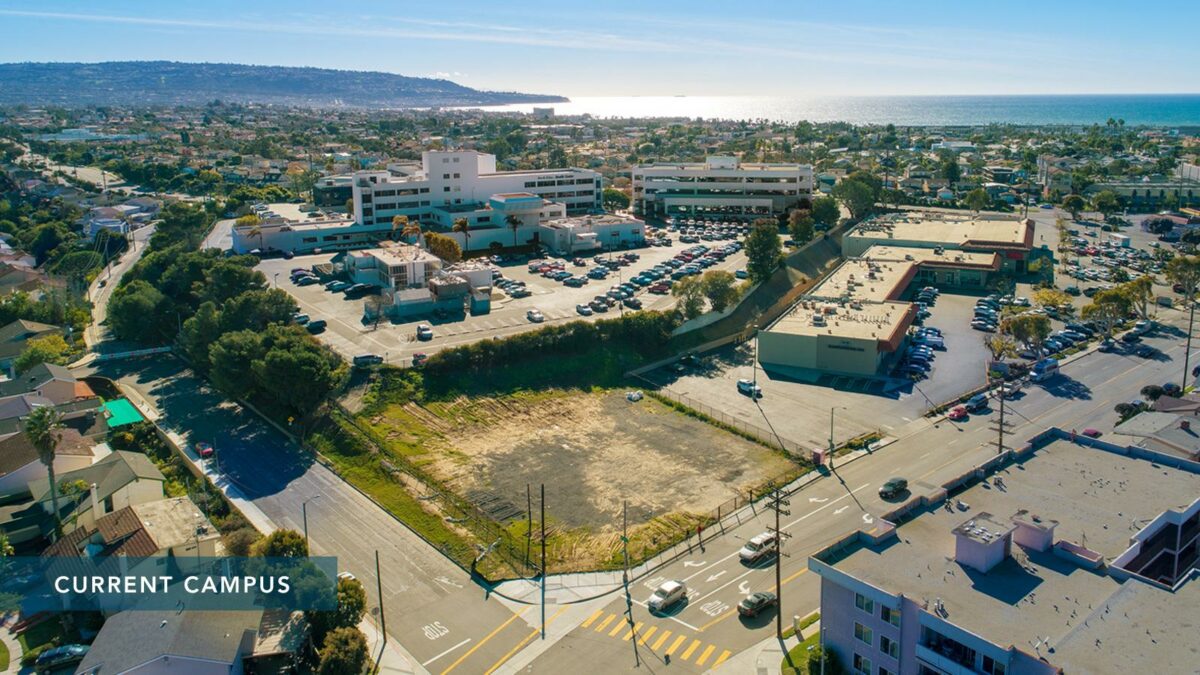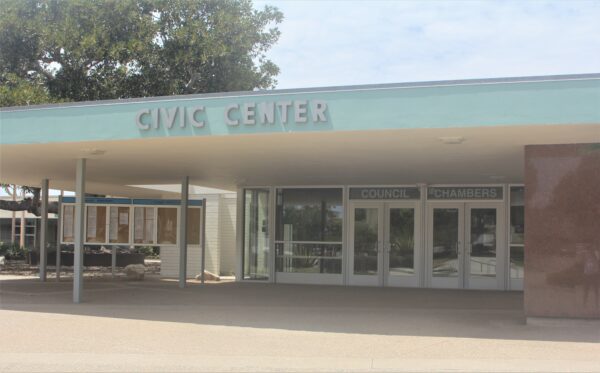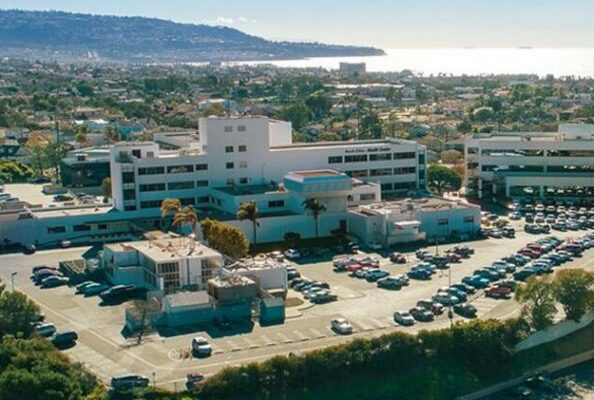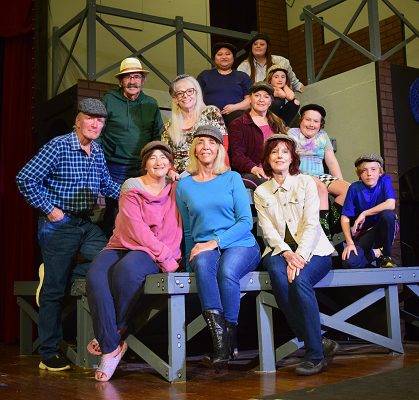by Garth Meyer
After a failed bond measure and a disbanded public-private partnership, the focus has shifted at Beach Cities Health District for its proposed Healthy Living Campus.
The partnership to build an assisted living complex and tear down the old hospital ends May 1.
In its place, the health district prepares a new request for proposals for a land lease of the hospital building and its parking lot.
Potential uses would be anything deemed health-related, including affordable housing.
The BCHD plans to be out of the old hospital by March 2027.
Also announced last week, BCHD’s Center for Health and Fitness will move from the old hospital to the third floor of the 510 building – nearest Prospect Avenue on the 11-acre campus in Redondo Beach – the lease approved April 23 by the BCHD board.
Though the district intended to tear down the 1960 hospital, citing seismic concerns (its demolition cost was part of the $30 million bond measure last fall) a developer could renovate the building and use it.
In the original scope of the Healthy Living Campus, the Center for Health and Fitness would have moved off campus during construction, and come back, to a not-yet-decided place.
PACE (Program for All-Inclusive Care for the Elderly), was set to be inside the large assisted living building. Discussions are now underway for it to move into the 510.
“In our mind, all of this is good news,” said Tom Bakaly, BCHD chief executive officer. “It’s less impact, as we don’t have to build new buildings.”
The shift comes after BCHD tightened its budget in recent years due to falling revenues from the hospital building; from $2.5 million in 2020 to $1.5 million today, after loss of tenants.
“We’ve reduced our expenses. We were receiving a lot more net revenue before from the (hospital) building. We’ve adjusted for that,” Bakaly said. “A land lease could cover the net revenue we were getting from the old building.”
He cited more grants coming in as part of the budget cuts, reductions in services and employees. More streamlining will be discussed in May by the BCHD board.
Mark Nelson, leader of the grassroots “STOPBCHD” movement, talks of concerns that a new developer could use density bonus laws to build something beyond what the city wants.
If a building has a certain percentage of affordable units, state law allows more density.
Nelson lives on Prospect Avenue, across the street from the campus.
“BCHD’s core function is not commercial real estate, yet that is basically what they have been proposing for 15 years,” he said. “The good thing about this new request for proposals is they’ll at least get a sense of where the market’s at and what alternative uses could benefit residents.”
Is this good news for STOPBCHD?
“It depends. You don’t know what the ultimate project looks like. You could imagine horrible outcomes and you can imagine positive outcomes,” Nelson said. “Conceivably, it could be senior housing, that is affordable, and dedicated to Beach Cities residents, with greenspace.”
The cost to renovate the old hospital would likely exceed $100 million. An estimate obtained by BCHD five years ago put it at $90 million.
The district’s November 2024 bond was part of an effort which could have cut the size of the proposed public-private construction – with PMB developers of Solana Beach, Calif.
“We were asking if the voters would cover the open space and the hospital demolition (taking those costs off of PMB’s hands) which would allow them to reduce the project to 160 units or so (from 217),” Bakaly said.
He noted that $6 million is still needed to build allcove at the corner of Flagler Lane and Beryl Street. If not, the youth health facility would be moved to AdventurePlex, to take up perhaps two-thirds of it, leaving the gym open.
As per the board’s vote to vacate the old hospital, the current leases for Center for Health and Fitness and Silverado Memory Care both end in March 2027.
“The big question is what’s going to go there when the building is (empty),” Bakaly said. “It could include affordable housing, assisted living, medical offices…”
Last Friday, April 25, he met with 100 people at a BCHD half-day strategic planning session, in part to discuss the future of the campus land.
The 510 building is owned by developer Ducot/Lazar, who built it in the 1970s.
Overall, the defunct deal with PMB now opens the scope of the Healthy Living Campus.
“Before, we were just looking at assisted living. Now we are looking at other opportunities,” Bakaly said.
The new request for proposals for the hospital will go out in the next two to three months, Bakaly said, and have a list of things a lessee would need to comply with.
“We’ll give guidance on height and density,” said Bakaly. “And where to locate (any new development), as we’ve heard concerns from residents to keep it away from the perimeter.”
Affordable housing?
“That is consistent with the land use. We believe there is a health nexus, one of the (main elements) of health is to have a place to live,” the CEO said.
He noted that senior or affordable housing can “fit there” on the hospital site in the range of 217-270 units.
“The Healthy Living Campus, there’s a lot more going on than the assisted living project,” Bakaly said.
PMB bowed out of the deal due to trouble financing and raising capital, he said.
“When they bid, it was a different time and a different project,” Bakaly said, of the 2021 deal. “It’s simpler now.”
If the agreement had come to fruition, PMB would have torn down the old hospital, replaced it with open space and built the allcove building.
Will the hospital still be demolished?
“I think it’s likely, with the condition that it is in, or a company could renovate it. That would be something that the board would consider,” Bakaly said.
The BCHD board needs to approve any lease and/or development plan.
A new investor may also be subject to limitations for how large it can build, since the city planning commission recommended the allowed floor area ratio on the campus be cut from 1.25 to .5.
“The city has adopted an E.I.R. (Environmental Impact Report) that shows 1.25 as no significant impact. Our opinion is not to limit it,” Bakaly said.
What did he hear at the BCHD’s half-day planning session?
“People were interested in medical use for the land, and affordable housing and assisted living. They were interested in all of those things,” he said.
Last Wednesday, the board took in a presentation about a feasibility study on affordable housing for the site – no action was taken but the board recommended a study of intergenerational housing (families, young professionals, older adults, retirees).
If allcove [the name is not capitalized] moved to AdventurePlex, it is unclear whether AdventurePlex would retain part of the building.
“Is there a way to keep the gym, to use for camps – things to look at,” Bakaly said. “It wouldn’t necessarily be completely allcove, but it would be mostly.”
A charitable giving campaign is underway to raise the $6 million for allcove – about half of its estimated construction cost.
“By March 2026, at the very least, we need to know what’s happening with allcove,” said Bakaly.
Further BCHD observers cite the costs which went into seeking and obtaining the PMB deal.
“Obviously, they’ve given up on the big project,” said Bob Pinzler, former city councilman and Easy Reader contributor. “It’s $12 million, $14+ million thrown away on lawyers, E.I.R., advertising and promotion.”
“We still have the E.I.R., which helped us get a $6 million grant for allcove. We spent money developing the project,” Bakaly said. “It was an investment in redeveloping the future of the campus, and some positive things have come out of that. The project has evolved. We’re able to do a lot of the master plan by moving Center for Health and Fitness and PACE into the 510 building. That was going to be in the new (PMB) building.”
BCHD first formed a working group for the Healthy Living Campus in 2017. Were the past eight years of work moot?
“We had a working group, and a plan that 90 percent of the working group supported. We’re implementing many pieces of it,” Bakaly said.
STOPBCHD now waits and watches.
“We’re not going to act while we don’t know, and we’re all guessing,” Nelson said.
Efforts to reach PMB for comment were unsuccessful. ER











Thanks to Garth for keeping an eye on BCHD.
Just a few comments.
As BCHD never ‘fesses up to, if the use the $6M ALLCOVE grant, then we – the taxpayers of the District only – must pay to operate ALLCOVE for 30-years for the benefit of LA County SPA8 – which is 91% non-residents of the 3 Beach Cities and includes Long Beach to Avalon to El Segundo to Compton. That’s a roughly a $175M taxpayer liability in return for a $6M grant. That a Benefit to Cost of $1 to $30. WHAT A BAD DEAL BCHD CUT – USING TAXPAYER MONEY AND LIABILITY.
As Pinzler notes, BCHD burnt up to $14M in taxpayer funding on pre-development of NO PROJECT costs. That’s what happens when an inexperienced Board and CEO buy consultants as their one-eyed man.
BCHD has squandered about $60M in reserves and exit fees from the commercial hospital that rented the 514 Building after it failed in 1984 as a public hospital. Where is our money? Where is the 60-years of property taxes that we’ve paid? In today’s dollars, that’s $300M in property tax alone. Where’d it go?
We have $2.4M per year in BCHD executives still. Why? Their decisions haven’t been good. $2.4M in EXECUTIVES (15% of total COST) to run a $15M per year GROSS REVENUE non-profit. That’s wildly excessive by greedy corporate terms even.